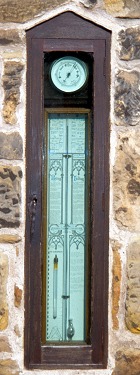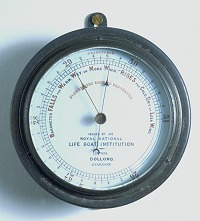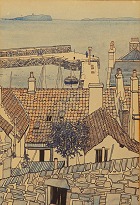Back to start | Fog | Next
Storms

These are the most dangerous weather condition for anyone at sea. They can brew up surprisingly quickly and, with very little warning. Weather systems far out in the ocean can create gale force winds, in turn whipping up huge waves that can swamp a boat, or capsize it. Winds can force a vessel off course or make it impossible for it to steer back to port. This was a big problem for sailing boat crews who depended on the wind for propulsion. A motorised vessel could try to get through the wind to the safety of the shore, but sailing boats had to try and tack or ride out the storm in open water before heading to land once the weather eased. The wind can also damage boats. It can rip off essential equipment such as sails or, in more modern times, radio masts. In extreme cases, the hull may be damaged by the sheer force of the waves.
Avoiding bad weather
The best way for fishermen to be safe at sea is to try to avoid the bad weather. The provision of barometers at harbours was very useful. These helped the fishermen to tell if there was going to be a change in the weather before they set out.

There were two types of barometers used in the 19th century. The aneroid barometer was first introduced in the 1840s. It shows whether the air pressure is high or low, with high pressure indicating settled weather and low pressure often foretelling bad weather. The second type was the marine barometer, designed by Admiral Fitzroy. It worked by dissolving camphor in water. Bad weather was forecast when the water in the barometer was cloudy. The marine barometer was commonly used in the second half of the 19th century.
Satellite weather forecasting is now used. This results in much more accurate forecasting. However, long-range weather is still unpredictable, and fishermen are often out at sea for periods of days or weeks. This means they cannot avoid being caught in a storm, no matter how sophisticated their equipment.
Fishing disasters

There have been many disasters at sea caused by storms, in particular sudden storms. Between the years of 1881 and 1890, there were 21 fishing disasters. The worst of these was the Eyemouth Disaster of 1881. After weeks of bad weather, the fishermen were impatient to go to sea. They ignored the low reading on their barometer and set off to fish on Friday 14 October 1881. Fishermen lost from the South East of Scotland lost that day totalled 181, with 129 from Eyemouth alone.

Another disaster was the East Neuk Disaster of 1875. On Monday 19 September five boats were lost in a storm with all hands. They were on their way home to Fife after the East Anglian herring season. On the evening before they were due to sail there was a bad storm but the following day it subsided so the boats set out for home. However, the storm blew up again suddenly and forced the boats to scatter.
In August 1848 there was a great storm on the Moray Firth. Captain Washington was commissioned to look into this.
Back to start | Fog | Next